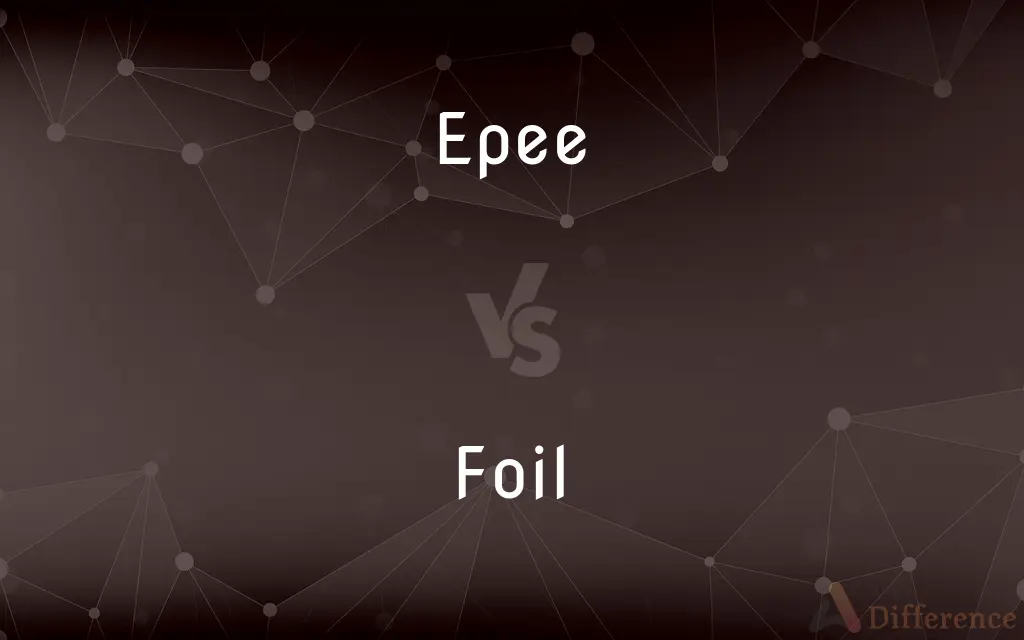Epee vs. Foil — What's the Difference?
By Urooj Arif & Maham Liaqat — Updated on April 4, 2024
Epee is a heavy thrusting weapon targeting the entire body, ideal for direct attacks, while Foil is a lighter weapon focusing on the torso, emphasizing technique and priority.

Difference Between Epee and Foil
Table of Contents
ADVERTISEMENT
Key Differences
The epee, one of the three weapons used in the sport of fencing, is characterized by its heavier weight and a larger guard to protect the hand. It is designed for thrusting, and hits are scored by touching any part of the opponent's body, mimicking a duel where any hit can be fatal. In contrast, the foil is a lighter weapon with a smaller guard, used primarily to train fencers in the art of attack and defense. Scoring is restricted to the torso, excluding the arms and head, reflecting its origins as a practice weapon for safe dueling.
In epee fencing, the entire body is a valid target area, which encourages a more cautious and strategic approach, as fencers must defend their entire body from attacks. This aspect makes epee matches potentially slower and more tactical. On the other hand, foil fencing limits the target area to the torso, promoting precision and control. This limitation requires fencers to develop sophisticated strategies and techniques to score points while protecting their valid target area.
The scoring system in epee fencing does not consider the right of way, meaning that if both fencers land a touch within a short window of time, both are awarded points. This rule reflects the weapon's philosophy where any touch could be lethal in a real duel. Conversely, foil fencing employs the right of way rule, which awards the point to the fencer who initiates the attack or who has priority if both land hits simultaneously. This emphasizes the importance of technique, timing, and the strategic use of feints and parries.
Epee matches often feature a wider variety of tactics, given the larger target area and the absence of right of way rules. Fencers can afford to be more aggressive or defensive based on their style and the match's context. Foil fencers, due to the emphasis on the right of way and a limited target area, often engage in complex exchanges of attacks, counterattacks, and parries, making foil bouts highly dynamic and fast-paced.
Understanding the differences between epee and foil not only enriches one's appreciation for the sport of fencing but also highlights the unique skills and strategies fencers must develop to excel in each weapon. Both weapons offer a distinct set of challenges and rewards, reflecting the depth and diversity within fencing.
ADVERTISEMENT
Comparison Chart
Weight
Heavier
Lighter
Target Area
Entire body
Torso only
Scoring System
No right of way; simultaneous touches count
Right of way applies; only attacker scores
Guard Size
Larger
Smaller
Emphasis
Direct attacks; strategy
Technique; priority
Compare with Definitions
Epee
No right of way; simultaneous touches are allowed.
Both fencers scored simultaneously in the epee match, each earning a point.
Foil
A lighter thrusting weapon focusing on technique, targeting the torso.
The foilist executed a perfect lunge, scoring a point on the opponent's torso.
Epee
A heavy thrusting weapon used in fencing, targeting the entire body.
The fencer scored a touch with her epee on the opponent's foot.
Foil
Right of way applies, emphasizing attack priority.
The foil fencer won the point by establishing right of way with a clean attack.
Epee
Encourages cautious and strategic gameplay.
The epee fencer waited patiently for an opening to launch a direct attack.
Foil
Promotes precision, control, and the strategic use of priority.
Foil fencers often engage in rapid exchanges to gain the right of way.
Epee
Entire body is valid for scoring points.
Epeeists must defend their whole body, as any touch counts as a point.
Foil
Equipped with a smaller guard.
The foil's smaller guard demands precise parries and counterattacks.
Epee
Features a larger guard to protect the hand.
The epee's larger guard provides better protection during close engagements.
Foil
Limited to the torso, excluding arms and head.
In foil, hits outside the torso, like on the arm, do not count as points.
Epee
A fencing sword with a bowl-shaped guard and a long, narrow, fluted blade that has no cutting edge and tapers to a blunted point.
Foil
To prevent from being successful; thwart
The alarm system foiled the thieves' robbery attempt.
Epee
The art or sport of fencing with this sword.
Foil
To obscure or confuse (a trail or scent) so as to evade pursuers.
Epee
(fencing) A sharp-pointed dueling sword with a bell-shaped guard, used (with the end blunted) in sport fencing.
Foil
To cover or back with foil.
Epee
A fencing sword similar to a foil but with a heavier blade
Foil
To wrap (strands of hair) in pieces of foil in order to isolate them after bleach or color has been applied.
Foil
To set off by contrast.
Foil
A repulse; a setback.
Foil
The trail or scent of an animal.
Foil
Metal that has been formed into a thin, flexible sheet
Aluminum foil.
Foil
A thin layer of polished metal placed under a displayed gem to lend it brilliance.
Foil
One that stands in contrast to and emphasizes the distinctive characteristics of another
"I am resolved my husband shall not be a rival, but a foil to me" (Charlotte Brontë).
Foil
The reflective metal coating on the back of a glass mirror.
Foil
(Architecture) A curvilinear, often lobelike figure or space formed between the cusps of intersecting arcs, found especially in Gothic tracery and Moorish ornament.
Foil
An airfoil.
Foil
(Nautical) A hydrofoil.
Foil
A fencing sword having a usually circular guard and a thin, flexible four-sided blade with a button on the tip to prevent injury.
Foil
Often foils The art or sport of fencing with such a sword
A contest at foils.
Foil
A very thin sheet of metal.
Foil
Thin aluminium/aluminum (or, formerly, tin) used for wrapping food.
Wrap the sandwich up in foil
Foil
A thin layer of metal put between a jewel and its setting to make it seem more brilliant.
Foil
In literature, theatre/theater, etc., a character who helps emphasize the traits of the main character and who usually acts as an opponent or antagonist, but can also serve as the sidekick of the protagonist.
Foil
(figuratively) Anything that acts by contrast to emphasise the characteristics of something.
Foil
(fencing) A very thin sword with a blunted (or foiled) tip
Foil
A thin, transparent plastic material on which marks are made and projected for the purposes of presentation. See transparency.
Foil
A premium trading card with a glossy finish.
Foil
(heraldry) A stylized flower or leaf.
Foil
Clipping of hydrofoil
Foil
Clipping of aerofoil/airfoil
Foil
Failure when on the point of attainment; defeat; frustration; miscarriage.
Foil
One of the incorrect answers presented in a multiple-choice test.
Foil
(hunting) The track of an animal.
Foil
(transitive) To cover or wrap with foil.
Foil
(nautical) hydrofoil
Foil
To prevent (something) from being accomplished.
They foiled my plans.
Foil
To prevent (someone) from accomplishing something.
I was foiled by my superior
Foil
To blunt; to dull; to spoil.
Foil
(obsolete) To tread underfoot; to trample.
Foil
(mathematics) To expand a product of two or more algebraic expressions, typically binomials.
Foil
(obsolete) To defile; to soil.
Foil
To tread under foot; to trample.
King Richard . . . caused the ensigns of Leopold to be pulled down and foiled under foot.
Whom he did all to pieces breake and foyle, In filthy durt, and left so in the loathely soyle.
Foil
To render (an effort or attempt) vain or nugatory; to baffle; to outwit; to balk; to frustrate; to defeat.
And by mortal man at length am foiled.
Her long locks that foil the painter's power.
Foil
To blunt; to dull; to spoil; as, to foil the scent in chase.
Foil
To defile; to soil.
Foil
Failure of success when on the point of attainment; defeat; frustration; miscarriage.
Nor e'er was fate so near a foil.
Foil
A blunt weapon used in fencing, resembling a smallsword in the main, but usually lighter and having a button at the point.
Blunt as the fencer's foils, which hit, but hurt not.
Isocrates contended with a foil against Demosthenes with a word.
Foil
The track or trail of an animal.
Foil
A leaf or very thin sheet of metal; as, brass foil; tin foil; gold foil.
Foil
A thin leaf of sheet copper silvered and burnished, and afterwards coated with transparent colors mixed with isinglass; - employed by jewelers to give color or brilliancy to pastes and inferior stones.
Foil
Anything that serves by contrast of color or quality to adorn or set off another thing to advantage.
As she a black silk cap on him beganTo set, for foil of his milk-white to serve.
Hector has a foil to set him off.
Foil
A thin coat of tin, with quicksilver, laid on the back of a looking-glass, to cause reflection.
Foil
The space between the cusps in Gothic architecture; a rounded or leaflike ornament, in windows, niches, etc. A group of foils is called trefoil, quatrefoil, quinquefoil, etc., according to the number of arcs of which it is composed.
Foil
A piece of thin and flexible sheet metal;
The photographic film was wrapped in foil
Foil
Anything that serves by contrast to call attention to another thing's good qualities;
Pretty girls like plain friends as foils
Foil
A device consisting of a flat or curved piece (as a metal plate) so that its surface reacts to the water it is passing through;
The fins of a fish act as hydrofoils
Foil
Picture consisting of a positive photograph or drawing on a transparent base; viewed with a projector
Foil
A light slender flexible sword tipped by a button
Foil
Enhance by contrast;
In this picture, the figures are foiled against the background
Foil
Hinder or prevent (the efforts, plans, or desires) of;
What ultimately frustrated every challenger was Ruth's amazing September surge
Foil your opponent
Foil
Cover or back with foil;
Foil mirrors
Common Curiosities
What is the main difference between epee and foil in fencing?
The main difference lies in the target area and scoring system, with epee targeting the entire body without right of way, and foil focusing on the torso with right of way rules.
Can both fencers score simultaneously in epee?
Yes, in epee fencing, if both fencers land a touch within milliseconds of each other, both score points.
Is footwork important in both epee and foil?
Yes, footwork is foundational in both weapons, crucial for positioning, defense, and executing attacks.
What is the 'right of way' in fencing?
Right of way is a rule in foil and sabre that determines which fencer gets the point when both land hits at the same time, based on who initiated the attack or had priority.
What tactical approaches are common in epee fencing?
Epee fencing allows for a variety of tactics, from aggressive attacks to strategic defenses, due to the larger target area and absence of right of way.
Can a fencer compete in both epee and foil?
Fencers can compete in both, but mastering each weapon requires understanding and adapting to its unique rules and strategies.
What makes epee fencing considered more strategic?
The entire body being a valid target and the absence of right of way make epee bouts more about patience and strategy to find or create openings.
Why is the target area in foil limited to the torso?
The torso is targeted in foil to simulate the vital areas in a duel, emphasizing precision and technique in attacks.
How do fencers train differently for epee vs. foil?
Training differs mainly in tactical and technical focuses—epeeists train to exploit the entire body as a target, while foilists focus on precision, timing, and right of way strategies.
How does the guard size differ between epee and foil?
Epee has a larger guard to protect the hand, reflecting its use in a duel scenario, while foil's smaller guard emphasizes the need for skillful defense and attack.
Why is technique particularly emphasized in foil fencing?
Technique in foil is crucial due to the limited target area and the importance of establishing right of way for scoring.
What is the historical origin of epee and foil fencing?
Epee evolved from the dueling sword, focusing on realistic combat simulation, while foil was developed as a training weapon for safe practice, emphasizing technique.
How do fencers score points in foil without hitting the valid target area?
In foil, points are only scored by hitting the valid target area (the torso); hits to non-valid areas do not count and do not stop the action.
How does the weight of the weapon affect fencing style?
The heavier epee demands more strength for control and can influence a slower, more deliberate style, while the lighter foil allows for quicker movements and demands agility.
What role does armor play in epee and foil?
Armor, or protective gear, is tailored to each weapon's rules—epeeists wear gear protecting the entire body, while foilists have gear emphasizing torso protection.
Share Your Discovery

Previous Comparison
Freerunning vs. Parkour
Next Comparison
Values vs. MoralAuthor Spotlight
Written by
Urooj ArifUrooj is a skilled content writer at Ask Difference, known for her exceptional ability to simplify complex topics into engaging and informative content. With a passion for research and a flair for clear, concise writing, she consistently delivers articles that resonate with our diverse audience.
Co-written by
Maham Liaqat














































